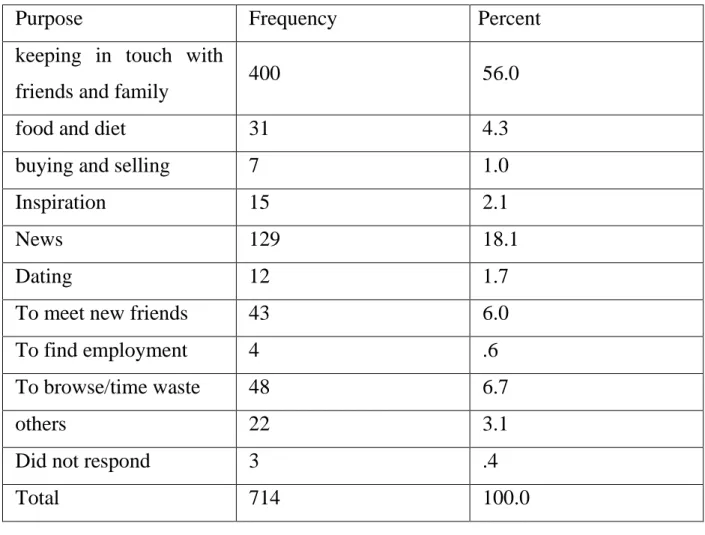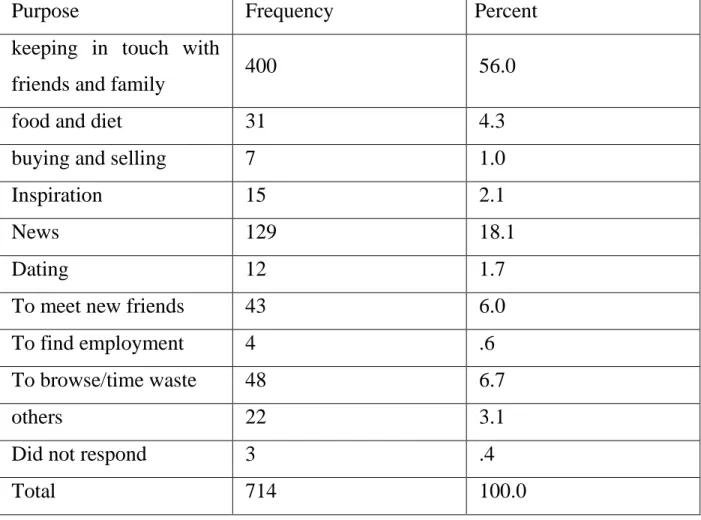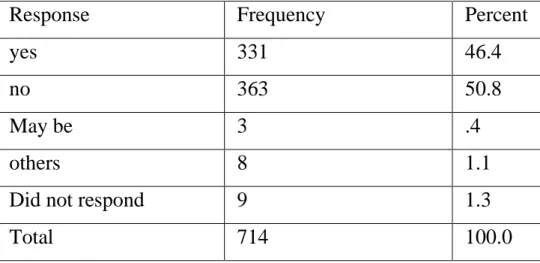Sohaeb Nabi Shetu rental ID is approved in partial fulfillment of the requirement for a bachelor's degree in nutrition and food engineering. Fouzia Akter Assistant Professor Department of Nutrition and Food Technology, Faculty of Allied Health Sciences, who had given me the opportunity to complete this project. The motivation behind this paper was to set up dietary awareness and change of eating patterns for university students by the influence of social networks and how these affect their eating behavior.
Out of 714 students, 400 students use the social network to keep in touch with friends and family and 31 students use the social network for food and diet and the percentage is 4.3. Out of 714, 353 students follow pages related to food and diet and the percentage is 49.4. Experiments show that 53.2 percent of students eat food from recommended sites rather than homemade food, and from this percentage we can easily say that the social network has an impact on the changes in students' food consumption. The percentage of propensity to follow food and diet related sites on social networks that is recommended is 54.2 percent and the number is 387 out of 714.
Most of the students think and believe that food and diet related sites influence eating patterns, while some of them are not sure whether these sites influence or not. Our dietary choices will additionally be generally combined with those on our social networking site. Online life combines a large number of visual parts of conventional media with an open door for online life consumers to convey and spread generalizations that can cause concerns about eating and self-perception.[2]
Furthermore, college students are generally preoccupied with academic work, games and are under emotional stress, which combined with unbalanced diets followed by social networking results in poor health and nutrition.
Specific Objective
Framework
Chapter-2 2.1 Operational Planning
Time of Activity
Review of Literature
Over the past decade, an expanding body of work has focused on the role that such systems can play in understanding the improvement of obesity and obesity. Despite growing recognition that social networks are essential to our understanding of weight, there is limited understanding to date about the ways in which such systems may shape the progression of obesity and fatness. Despite significant research on informal communities and weight status since 2007, the field remains undervalued, limiting progress in elucidating the clustering of overweight and obesity within specific social networks.
By reviewing the writing, this article provides a diagram of the ways in which the web has been understood and their relationship to overweight and obesity. It draws from a sociological understanding of social processes as instances of events that occur as a result of connections between individuals to elucidate how systems may promote the progression of overweight and obesity.[7] This empowers the social and societal part of food use and dietary practices to be tamed.
This measurement, instead of the natural part of sustenance and sustenance, has been called the severity of the omnivore. Subsequently, social meaning and allegories of sustenance may coordinate dietary decisions and determine what kind of sustenance confers social recognition. The term "nutrition pornography" goes back to 1979, when Michael Jacobson, co-creator of the Center for Science in the Public Interest, needed to distinguish between healthy and junk foods - "Secret Sauce" and "Nurishment Porn" - in the association's bulletin.
Accordingly, the meaning of nutrition and diet as a general social and social phenomenon is constantly changing. Between the sixteenth and twentieth centuries, Europe and its landscapes changed from mercantilism to private enterprise. The purpose of this investigation is to increase the understanding of the relationship between SNS and eating tendencies and to investigate whether Internet lifestyle use affects eating plans.
The purpose of this study was to investigate whether food pornography influences eating patterns. More explicitly, it was speculated that presentation to inviting food photos on SNS would increase the level of nutritional cravings and appearance eating and influence the type and degree of nutrition requested from a menu. . Unlike cravings, delectable food pictures did not affect food appearance, food cravings, or the type or amount of food requested from a menu. Furthermore, seeing food photos did not affect people with food confusion any more than others did on either factor.
Chapter-3
Equipment
Methods and Materials .1 Key variables of the study
- Study Locations
- Study Design
- Study population
- Study period
- Participants’ number and their range of age
- Assent
- Advancement of the survey
- Information check
- Measurable Analysis and Methods Used
- Restrictions of the examination
Comparison of eating between preferred foods available on food sites and foods prepared at home. Changing the trend of university students and the relationship between the social network and this change. To consider the healthy status, dietary behavior, the influence of the social network on the changes in the dietary pattern and the resulting complexity of Daffodil International University undergraduate, the study area was Daffodil International University.
The information for this study was obtained through meetings close to the home of each respondent on organized polling, including both open-ended and closed-ended surveys. Dietary data, past and present influence of social networks on dietary pattern and survey-related data were taken from the selected respondent. 3.2.4 Study population. The subjects of the study were students from Daffodil International University aged 18 to 24.
The reason and nature of the examination was made known to each member and in the wake of the composite consent they were enrolled in the examination. A standard survey was created to get the significant data related to the general data, financial data and individual data. Changes of dietary pattern were recorded according to the use of social network. 3.2.9 Information control.
The charts were checked daily on the eve of the meeting and again these were carefully checked after the collection of all the information was collected and coded before being entered into the computer. to limit errors, in the course of entering the informative index on the PC, these are checked and resolved by legal means.
Chapter-4 4.1 Results
Discussion
We conducted a study on the influence of social networks on changes in the dietary patterns of university students. Initially, the survey in the analysis of background information has shown that the respondents are 38.1 percent from rural areas and 60.8 percent from urban areas. In this study, the analysis shows that 673 students out of 714 use social networks and the percentage of male students is more compared to female students.
In agreement with Gerlich et al., the researchers found no statistically significant differences between men and women in the amount of time spent using the Internet. In addition, no fundamental differences between women and men in terms of social media use were discovered. Finally, participants (32%) explained that social media can be a source of distraction during meal times and when making food choices.[12] On the other hand in this study it shows out of 714, 353 number of students follow the food and diet related pages and the percentage is 49.4 and the cumulative percentage is 50. In the case of social network finishing on daily usual food consumption, it was recorded that 46.4 percent students said it is true that the social network really affects their daily usual food consumption.
At one point, the experiments show that 53.2 percent of students eat food from recommended sites rather than home-cooked food, and from that percentage we can easily say that social networks have an influence on changes in students' food consumption. In a study of the perceived influence of social media on the health behaviors of young adults, they attempted to compare online ordered fast food vs. In the case of addiction to food and diet related sites on social networks, it has been studied that 24.9 percent of students are addicted to food and diet related sites, and the number is 178 out of 714.
Rest of 74.1 percent of students are not addicted to food and diet related sites and the number is 529 out of 714. So here is one point that is whether students follow food and diet related sites after certain verification or no. After the examination or analysis, it is recorded that 255 number of students out of 714 do verification about the recommended food and diet pages in their social network and the percentage is 35.7 percent, but the rest of the 290 students never do any authenticity check. of recommended sites related to food and diet and 163 number of students have never tried to do the verification check.
We cross-tabulated the gender and following of each food-related social media site among the 714 student population. After analysis, we realized that men follow more pages related to food and diet than women. Most of the students think and believe that food and diet related sites have influence on the dietary pattern, while some of them are not sure about the fact that these.
Chapter-5 5.1 Conclusion
Recommendation
Students should follow any site related to food and diet not because of the trend but for a healthy and logical purpose that would be a reason to stay healthy. Students should not follow any site related to food and diet without any verification of the said sites information. You should focus on healthy food, whether it comes from the influence of food and diet related sites or homemade.
Chapter - 6
Christopher Holmberg, PhD candidate, Food and Nutrition Sciences, University of Gothenburg (2015). Food and Social Media – A complicated one. Reasons to use social networking sites in their daily lives. Whitney Sue Thoene 2012, The Effect of Social Networking Sites on College Students' Consumption Patterns, available at: https://mds.marshall.edu/etd).









